Abstract
Nevada’s unique characteristic significantly affects its inhabitants’ health conditions, including maternal and child health status. Based on reports from the United States Census Bureau, 5.7% of Nevada’s population is below five years old, while about 22.2% of Nevadans are below 18 years old.
Nevada’s birth rates rank relatively among other states in the U.S. The state is ranked 24th out of 50, with a birth rate of 10.9. As a result, Nevada recorded 33,883 births between July 2020 and July 2021. Nevada’s infant mortality rate stands at 4.64, which raises concerns given the increasing health risks in the region. The southern part of Nevada has an infant mortality rate of 6.5, nearly matching Arkansas’ rate of 7. The leading causes of death in the area are heart disease, cancer, and chronic respiratory illnesses.
Nevada has a 39% maternal drug abuse rate, while poverty and high terminal conditions rates among women affect their health, thus affecting the health of infants and children. Medical coverage among minority mothers and their children is equally low in Nevada, whereas a short supply of medical professionals in the region jeopardizes care provision to mothers, infants, and juveniles. The Centers for Disease Control and Prevention (CDC) links ruralness, severe weather situations, poor air quality, prostitution legalization, and inadequate care providers and facilities to the increased deaths among mothers and young children in the state. The $ 5 million grant award will be instrumental in funding statewide programs for maternal anti-drug and alcohol abuse campaigns and care access promotion among all Nevadan mothers and infants.
Introduction
Nevada is a significantly unique state in the United States of America (U.S.) based on several aspects, including population composition and land ownership, among other elements. The state is America’s most semi-arid, with the largest population size living in urban settings. Nevada’s weather is equally unique, where most of the area experiences long winters and short summers. Therefore, Nevada’s distinctive features have a significant impact on the health conditions of its residents, particularly maternal and child health.
Description of Nevada Population
Nevada has experienced constant population growth for a long time now since the 1960s. According to Lyon et al. (2020), many people migrating to the U.S. during the nineteenth and twentieth centuries avoided Nevada due to its severe environmental conditions. The United States Census Bureau (2022) provides Nevada’s population estimates as of July 2022 to be 3,177,772 persons. The 2022 value represents a 2.4% growth in inhabitants relative to the 2020 population size. Furthermore, about 5.7% of the Nevadans are young children below five years, while the under 18 years fellows make up 22.2% of the state dwellers.
Age Structure
Nevada’s population is significantly young based on the state’s age structure. About 22.2% of Nevadans are further below 18 years old, mostly living with their mid-life or elderly parents (United States Census Bureau, 2022). Individuals above 65 years in the region constitute 16.5%, according to the United States Census Bureau (2022). The situation means that 83.5% or approximately 84% of Nevada’s citizens live below 65 years. Consequently, the high number of productive inhabitants in Nevada, coupled with the unfavorable conditions for women, implies special needs among expectant mother and their babies.
Nevada Counties
Nevada comprises several counties with varied population sizes. According to Cubit Planning, Inc. (2022), Nevada has 17 counties, as shown in Figure 1. All of them have varied numbers of inhabitants, with the population size revealing a lot about the counties’ habitability. Accordingly, Clark County has the largest number of citizens, with a population size of 2,231,147, as per the 2021 American Community Survey (Cubit Planning, Inc., 2022). Esmeralda has the lowest population in the state, with only 987 people, according to the 2021 American Survey (Cubit Planning, Inc., 2022). Thus, Nevada’s unbalanced population distribution leads to significant disadvantaging of individuals living in remote states, who generally lack access to quality health care, especially mothers with children.
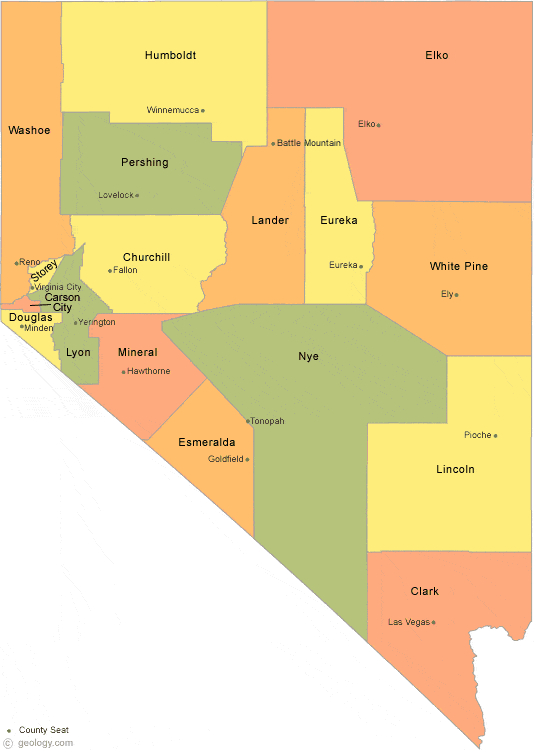
Note. Map showing Nevada’s 17. Adapted from Nevada counties by population, by Cubit Planning, Inc., 2022, in the public domain.
Components of Change
Political, social, and economic changes contribute significantly to Nevada’s population changes. However, economic and social factors contribute more to the variations. For example, the state’s population grows mostly through migration from other states. Hugo (2019) notes that avoiding social pressure in overpopulated areas, especially urban settings, is a chief social force leading to local migration. The search for greener pastures during migration to the state provides the economic reason for the change. Therefore, Nevada is a remote state with vast free land and significantly open economic opportunities, which are the two leading causes of change in population and other life facets.
Race/Ethnicity
Nevada is a white state, based on the race’s high number of citizens and incomparably reduced sizes of minority ethnic communities, as shown in Figure 2 below. The United States Census Bureau (2022) reports the percentage of white alone dwellers as 72.8%, meaning that only 27.2% are colored. Unlike many other American states where Whites dominate, followed by Blacks, Nevada’s case is notably different. Hispanics constitute 29.9% of the total population, Asians constitute 9.1%, and Aboriginals constitute 1.7% (United States Census Bureau, 2022). Moreover, whites alone make up 46.6% of the general population, which is roughly equal to half of the state’s inhabitants (United States Census Bureau, 2022). Accordingly, Nevada’s racial combination, coupled with unfavorable natural conditions, elicits the need for concerted efforts to improve the state’s health conditions, especially for mothers and children.
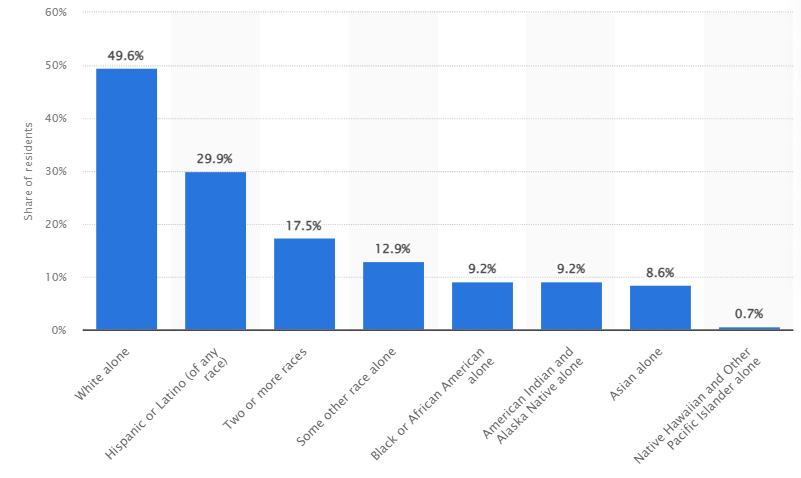
Note. Summary of Nevada’s population as of 2021 by race and ethnicity. Adapted from QuickFacts Nevada, by United States Census Bureau, 2022, in the public domain.
Household Characteristics
Nevada’s housing condition is substantially below par due to the clear gap between the population and available housing units. The state had about 1,305,509 housing units as of 2021, relative to the total population of over three million individuals (United States Census Bureau, 2022). Similarly, individuals owning personal houses contribute 57.8%, leaving the other group dependent on rentals. The monthly housing cost in Nevada is equally lower at $1,655 for those servicing mortgages, while minorities spend about $454 a month on housing expenditures. Thus, Nevada’s disproportional land ownership and water scarcity explain the evident housing issues.
Birth Rates
Nevada’s birth rates are comparable to those of other American states. The locality occupies position 24 out of 50, with a birth rate of 10.9 (Centers for Disease Control and Prevention (CDC), 2023). According to the CDC (2023), Nevada registered 33,883 births between July 2020 and July 2021.
The figure lags behind other states, such as Utah, Alaska, North Dakota, and Texas (CDC, 2023). Accordingly, occupying position 24 is not a mean achievement for Nevada. That is because of the state’s deranged conditions, which make life significantly harder compared to many other areas in the country.
Death Rates
Nevada exhibits higher death rates compared to the national averages. For example, the state’s crude death rate in 2020 was 10.6, relative to America’s 10.3 (Ely & Driscoll, 2021). The crude death rate figure for Nevada amplified from 7.7 deaths per 100,000 population in 2013 to 10.6 in 2020, marking a worrisome growth rate of 3.68% (CDC, 2020). Heart diseases, cancer, and chronic respiratory complications are the leading three killer conditions in the region, with rates of 199.3, 155.3, and 50.0, respectively (CDC, 2020). The conditions imply problems in the environment, with pollution being a principal contributor to the high death rates challenge.
Marriage Rates
Nevada features a substantially peculiar trend in matters of marriage compared to other American states. For example, the state registered the highest marriage rate in the country in 2020, with 21 matrimonies per 1,000 occupants. The figure is highly unique, based on the fact that the second state, Montana, has only a 10.4 marriage ratio (CDC, 2019). Thus, Nevada’s special traits give it spectacular features that are relatively different from those of the entire nation in several matters.
Infant Deaths
Nevada records a significantly high infant death rate compared to several other states in the U.S. Nevada’s infant mortality rate is 4.64, which is a cause of concern based on the rising health threats in the area, particularly from pollution and unfavorable climatic conditions. Notably, Nevada’s south has infant death rates of 6.5, which almost match that of Arkansas, 7.00 (March of Dimes, 2023a). The CDC (2020) links rural-ness, severe weather situations, and poor air quality to increased deaths among young children in the U.S. Combining the pollution factor with the unhealthy environmental conditions thus exposes Nevada infants to increased death risks worth curbing.
Healthcare Workers, Hospitals, and Other Medical Settings
Nevada generally fares unfavorably in terms of healthcare workers’ availability and hospital access. Nevada State College (2019) reports that the state lacks adequate healthcare specialists in all professions. Therefore, Nevadans experience a deficiency in quality care access, where many people have to travel to neighboring states to seek essential services. Consequently, such issues, coupled with increased pollution and other medical risks unique to the state, make Nevada a state in need.
Nevadans’ General Health
Nevadans struggle significantly with health issues due to their unfriendly surroundings. Heart diseases, cancer, respiratory complications, diabetes, suicide, and diabetes are some of the leading killer conditions in the state (CDC, 2023). Homicide and drug overdose equally contribute substantially to the region’s high mortality rate of 10.6 (Ely & Driscoll, 2021). Approximately 40% of mothers with children in the state abuse drugs that affect their health and that of infants (March of Dimes, 2023b). Remoteness, poverty, high pollution rate, lack of adequate physical activity, and prostitution’s legalization are the principal causes of ill health among the population.
Focus Area
Background
Nevada is a substantially tough state to live in due to several factors. About four-fifths of Nevada’s land belongs to the government, which hosts the area’s prolific gold, copper, and silver mines (United States Census Bureau, 2022). Another portion of the state-owned land serves as a military training ground, where soldiers and war specialists try various war techniques and ammunition. Figures 3 and 4 below show the region’s land ownership, with the government owning 58,226,015.6 acres out of 70,000,000 acres.
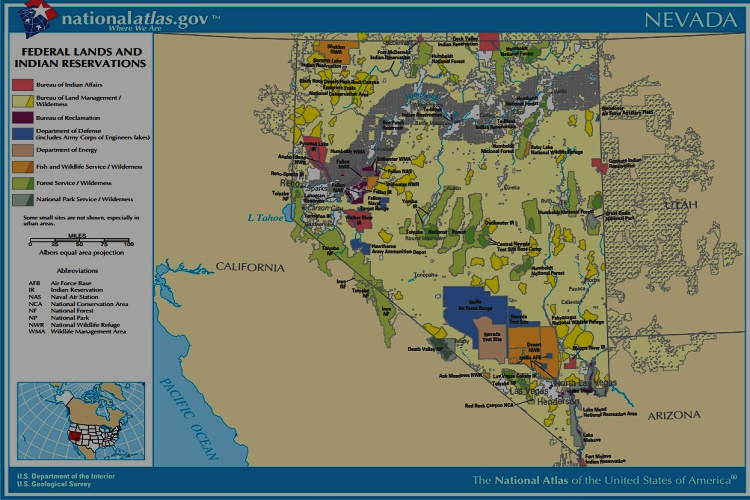
Note. Map showing the government’s majority land ownership in Nevada. Adapted from Here’s How Land is Used by the Federal Government in Nevada, by Las Vegas Review-Journal, Inc., 2023, in the public domain.
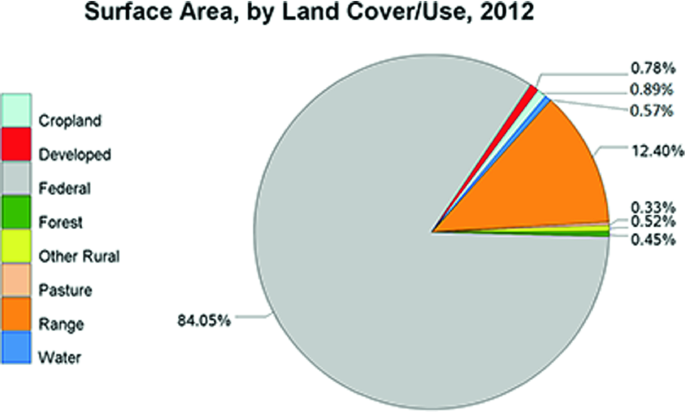
Note. Figure showing the government’s majority land utilization in Nevada. Adapted from Land Use in Nevada, by Blackburn, P., Fisher, J., Dollarhide, W., Merkler, D., Chiaretti, J., Bockheim, J., 2021. In the public domain.
Nevada’s Popular Occupations
Jobs in Nevada mainly come from the tourism, mining, and agricultural sectors. The state’s high-volume casinos, located mostly in Las Vegas, equally pull lots of people to the location throughout the year, promoting real urban life. Prostitution is legal in Nevada, according to Grittner and Walsh (2020), with the aspect eliciting notable concerns regarding young females’ health and that of their children. Grittner and Walsh (2020) state that living in Nevada as a single woman is harder relative to several other locations in the U.S. since almost all the available jobs for persons lacking higher education involve excessive use of physical energy. The matter makes almost all unmarried young females dependent and vulnerable, with the issues affecting even the mothers’ children (Skilbrei, 2019). Accordingly, this section explores the various healthcare-linked factors critical to maternal and child health in Nevada to show the state’s true position regarding the matter.
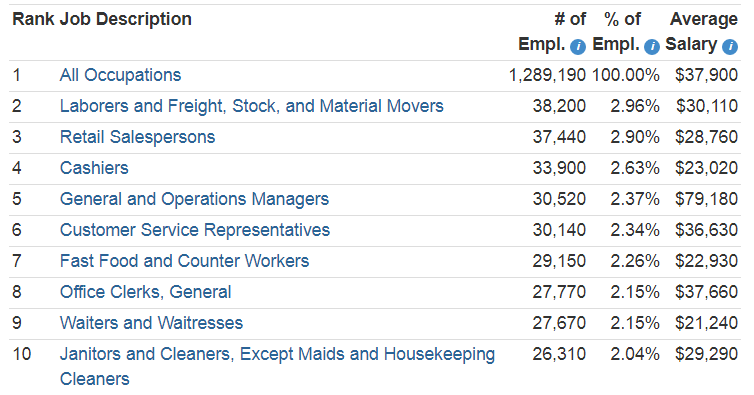
Note. Summary of Nevada’s most popular services-oriented jobs and their pay. Adapted from Top 200 popular jobs in Nevada, by USAWage.com, 2022. In the public domain.
Top Three Focus Issues
Access to Care and Postpartum Depression
Almost every healthcare aspect concerning maternal and child care in Nevada is inadequate. According to the CDC (2022), 15.2% of Nevada’s population lacks health insurance, with the majority being minority women, particularly young, unemployed mothers often raising children born from teenage pregnancies. Equally, the cost of care in the U.S. grows significantly every year, with the citizens generally bearing the matter because of dependence on insurance contracts. However, persons without medical cover experience hardships first-hand without anything they can do. The outcome of such situations is the perpetual tribulations among citizens and the inability to realize the set health care milestones for the entire state or country. Accordingly, Nevadans lacking health care coverage, most of whom are minority mothers taking care of their young children, proves Nevada’s defective situation regarding maternal-child care.
Post-delivery depression is a real medical problem among mothers taking care of young children. Nevada Statewide Maternal (2023) notes that concerns about the child’s well-being, food, and other intricate fears make the mother psychologically troubled. Furthermore, there is a higher incidence of postpartum depression among unemployed, unmarried, and mentally disturbed mothers.
Therefore, Nevada’s maternal and child health requires immediate intervention based on the state’s 20% postpartum depression level (Nevada Statewide Maternal, 2023). As per Nevada Statewide Maternal (2023), 1 in 5 moms in Nevada exhibits post-delivery depression for various reasons. Poverty, limited care access, ill health, and lack of access to hospitals due to distance are contributing factors to the high rate of depression among the group. Almost all these causes are manageable, implying the state’s or people’s ability to help through intervention programs.
Physical Exercise and Nutrition Care and Availability
Physical exercise is an essential health factor linked to numerous conditions affecting humans. Being physically active reduces conditions such as obesity and cardiovascular complications that contribute to Nevada’s high death rates (CDC, 2020). Postnatal mothers need to be physically active to promote physical and mental wellness.
However, Nevada lacks adequate facilities for these essential practices, while physical workout coaches in the state remain very few (CDC, 2020). Many women delivering babies in the state generally remain indoors until they can return to work, for those in formal employment. The CDC (2020) reports that cardiovascular complications comprise the leading killer conditions among Nevada’s elderly and breastfeeding minority mothers. Thus, the lack of adequate exercise facilities and healthcare professionals specializing in the field reveals Nevada’s defective situation.
Nevada lacks nutritionists and adequate food to keep the population fit. The problem affects different groups variedly, where minorities suffer the most. According to Cubit Planning, Inc. (2022), most African Americans and Hispanics in Nevada live in urban settings where surviving requires money. Minority groups frequently engage in menial jobs for a living, with life favoring men.
Cubit Planning, Inc. (2022) states that the number of men and females in Las Vegas is almost the same. A larger percentage of the female urban dwellers lacking stable jobs are minorities with a child or within the active childbearing age (Center for American Progress, 2022). Delivering a child when a minority Nevadan woman lacks a permanent job or stable family support leads to malnutrition among mothers and their children.
Additionally, inadequate nutritional professionals in the state make the condition worse. Nevada State College (2019) reports that the region lacks enough medical professionals in all dockets, implying a substantial gap in care access. Therefore, the lack of enough food, coupled with scant nutritional specialists in the state, disadvantages nursing mothers and babies disproportionately.
Table 1 – Popular Nursing Occupations in Nevada.
Note. Data showing Nevada’s deficiency in health professionals. Adapted from A Look at Nursing in Nevada, by Nevada State College, 2019. In the public domain.
Substance Abuse and Unemployment Insurance
Alcoholism and substance abuse constitute real medical issues among Nevadans. The CDC (2022) reports that 12.7% of state dwellers are binge drinkers. The population mainly comprises minorities, with the number of men and women almost matching. As per de Angelis et al. (2020), alcohol and substance abuse contribute significantly to illnesses affecting humanity.
Furthermore, individuals suffering from heart-related terminal illnesses must avoid the material to regain stable health. Accordingly, the point that drinking and drug abuse are prevalent issues in Nevada makes the state medically wanting. The CDC (2022) purports that many mothers living in Nevada’s urban setting consume alcohol, thus ruining their health.
The condition is notably worse among the many young mothers serving as bartenders and casino servers for survival. Skilbrei (2019) observes that mothers abusing alcohol and other substances while serving in the legalized prostitution industry never adequately protect themselves against conditions such as HIV and STIs. Thus, the high alcoholism, substance abuse, and terminal illness prevalence among Nevadan mothers implies the reality concerning the state’s desire for maternal and child health.
Nevada’s high unemployment insurance rate significantly affects maternal and child health in the area. About 60% of the state’s inhabitants work in the informal sector, meaning their income is not permanent. The matter affects mothers substantially, especially during pregnancies and baby nursing periods (Center for American Progress, 2022).
The Center for American Progress (2022) provides a lack of financial stability as a significant source of postnatal sadness among young mothers. The inability to provide for one’s child or self during the critical post-delivery time causes real psychological pain. However, the Center for American Progress (2022) articulates that 30.3% of Nevadans, especially women, do not have access to unemployment coverage. The issue leads to intensive worries when a mother cannot go to work due to expectancy or delivery. Accordingly, the lack of unemployment insurance among Nevadan moms is a significant risk factor contributing to the population’s ill health and instability.
Table 2 – Infant Health Comparison.
Note. Data showing Nevada’s infant and mothers’ increased complications risk relative to two neighboring states, California and Idaho. Adapted from State summaries. Peristats, by March of Dimes, 2023a. In the public domain.
Rationale
Nevada’s Strengths and Weaknesses: Why the State is Worthy of the Funding
Nevada exhibits several strengths that can be utilized to overcome the many healthcare-related plights with the appropriate support. For example, the above analysis shows that the region has a highly gifted population in education and skills. Only below fifteen percent of the inhabitants lack high school education (CDC, 2022), implying the state’s rich endowment academically.
Moreover, Nevada has one of the best transportation infrastructures in the entire U.S. (Naor et al., 2021). The area’s massive mineral deposits make it highly valuable to the government, leading to the development of quality connection lines. Therefore, Nevada can benefit through initiatives such as mobile clinic establishments and the effective implementation of a functional e-care system.
Nevada’s generally educated youths can equally access donations to specialize in medical disciplines through specialized short courses to bridge the gap in trained healthcare providers in the state. Accordingly, all these facets reveal Nevada’s unique social and academic infrastructure that can be used to solve the matter.
However, a significant weakness is Nevada’s deprived health position relative to the national estimates. The fact that no other American state features similar traits to Nevada justifies the dire need for aid to improve the region’s care and make America a great nation. As previously noted, Nevada is the nation’s most semi-arid region, with climatic conditions remaining unique. Nevada would greatly benefit from the $5 million grant that will make the state realize equity in matters of care delivery.
Purpose
Interventions
Mobile clinics’ initiation, sensitization, state-sponsored diapering resources, and drug and alcohol screening services are all possible interventions with the ability to improve maternal and child health in Nevada. The state’s most medically deprived mothers and children live in rural areas and lack access to city- or town-based hospitals (CDC, 2020). Initiating mobile clinics and functional e-care systems will eliminate the distance constraint affecting the citizens due to poverty and other physical hindrances.
Additionally, the diapering scheme will help qualifying mothers acquire free diapers for their children’s health to prevent avertible infections (Nevada Statewide Maternal, 2023). Sensitization further promises to resolve issues such as drug and alcohol dependence while informing young mothers of the need to quit the prostitution business for personal and the child’s sake. Lastly, the grant will finance drug abuse screening among the population to ensure proper treatment and care among all needy mothers and underage teenagers.
Conclusion
Nevada presents considerable challenges for residents due to a variety of factors. Most of the region’s population lives in urban establishments, especially in Las Vegas, where the cost of living is significantly high (United States Census Bureau, 2022). Cubit Planning, Inc. (2022) reports that about four-fifths of Nevada’s land is owned by the government, which also contains the region’s rich gold, copper, and silver mines that contribute meaningfully to the region’s high environmental pollution.
Almost all aspects of maternal and child healthcare in Nevada are inadequate. As CDC (2017) reports, a considerable portion of Nevada’s population is without health coverage. They are minority women, especially young, unemployed mothers raising children from teenage pregnancies (CDC, 2017). Nevada’s unemployed, unmarried, and mentally unwell mothers exhibit increased cases of postpartum hopelessness (Nevada Statewide Maternal, 2023). Accordingly, mothers with sickly children or families with terminally ill relatives, particularly when they are the primary breadwinners, have higher chances of falling into postnatal sadness.
The health of mothers and children in Nevada is in grave jeopardy. Mothers in the state experience 20% postpartum depression (Nevada Statewide Maternal, 2023). According to the CDC (2017), there are insufficient physical exercise facilities in Nevada, and there are still relatively few physical training instructors in the state. Nevada’s unemployed women primarily spend their time indoors nursing and doing little exercise, according to the CDC (2017).
Nevada has a highly gifted population in education and skills. The state further has one of the best transportation infrastructures in the country, while electricity is widely accessible by most of the state dwellers (Naor et al., 2021). The strengths provide favorable conditions for mobile clinics, sensitization forums, and drug abuse screening and treatment interventions fundable through the grant.
The grant will also offer medical coverage to the many insured mothers, provide educational support to locals intending to train in the healthcare profession and improve feeding programs for mothers and infants. Lastly, the grant will boost ARV access to mothers and children with HIV infections and initiate public programs that can boost job availability to alleviate poverty among socioeconomically deprived families with infants.
References
Blackburn, P., Fisher, J., Dollarhide, W., Merkler, D., Chiaretti, J., Bockheim, J. (2021). Land Use in Nevada. In: The Soils of Nevada. World Soils Book Series. Springer, Cham. Web.
Centers for Disease Control and Prevention (CDC). (2017). National center for chronic disease prevention and health promotion, division of population health. BRFSS Prevalence & Trends Data. Web.
CDC. (2019). Stats of the State of Nevada. Web.
CDC. (2020). Infant Mortality Rates by State. Web.
CDC. (2022). National center for chronic disease prevention and health promotion, division of population health. BRFSS Prevalence & Trends Data. Web.
CDC. (2023). Nevada: Key Health Indicators. Web.
Center for American Progress. (2022). Nevada. Web.
Cubit Planning, Inc. (2022). Nevada counties by population. Web.
de Angelis, C., Nardone, A., Garifalos, F., Pivonello, C., Sansone, A., Conforti, A. & Pivonello, R. (2020). Smoke, alcohol and drug addiction and female fertility. Reproductive Biology and Endocrinology, 18(1), 1-26. Web.
Ely, D. M. & Driscoll, A. K. (2021). Infant mortality in the United States, 2019: Data from the period linked birth/infant death file. National Vital Statistics Reports, 70 (14), 17-29. Web.
Grittner, A. L., & Walsh, C. A. (2020). The role of social stigma in the lives of female-identified sex workers: A scoping review. Sexuality & Culture, 24(5), 1653-1682. Web.
Hugo, G. J. (2019). Demographic and welfare implications of urbanization: Direct and indirect effects on sending and receiving areas. Urbanization and Urban Policies in Pacific Asia, 136-165.
Las Vegas Review-Journal, Inc. (2023). Here’s how land is used by the federal government in Nevada. Web.
Lyon, E. C., McGlue, M. M., Erhardt, A. M., Kim, S. L., Stone, J. R., & Zimmerman, S. R. (2020). Late Holocene hydroclimate changes in the eastern Sierra Nevada revealed by a 4600-year paleoproduction record from June Lake, CA. Quaternary Science Reviews, 242, 106432. Web.
March of Dimes. (2023a). State summaries. Peristats. Web.
March of Dimes. (2023b). Smoking/Alcohol/Drugs. Web.
Naor, M., Coman, A., & Wiznizer, A. (2021). Vertically integrated supply chain of batteries, electric vehicles, and charging infrastructure: A review of three milestone projects from theory of constraints perspective. Sustainability, 13(7), 3632. Web.
Nevada State College. (2019). A look at nursing in Nevada. Web.
Nevada statewide maternal and child health coalition (2023). Web.
Skilbrei, M. L. (2019). Assessing the power of prostitution policies to shift markets, attitudes, and ideologies. Annual Review of Criminology, 2(1), 493-508. Web.
United States Census Bureau. (2022). QuickFacts Nevada. Web.
USAWage.com. (2022). Top 200 popular jobs in Nevada. Web.